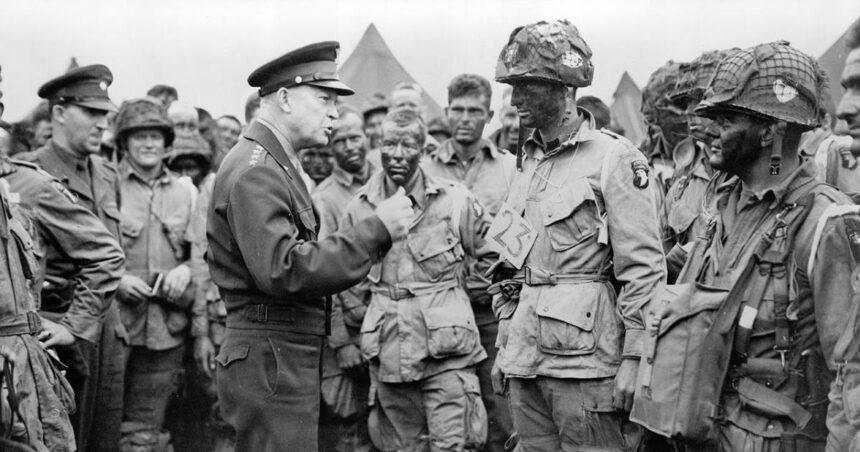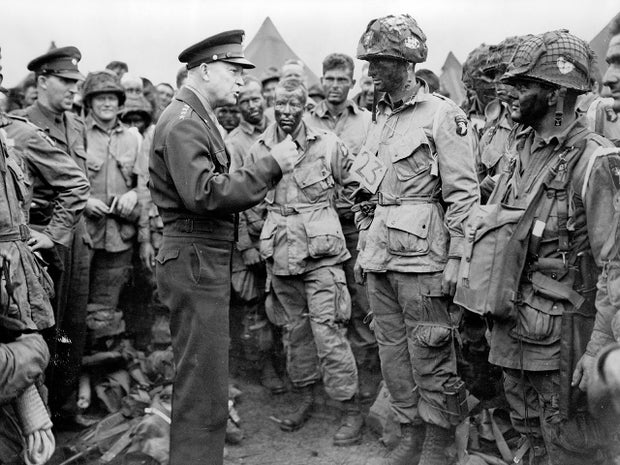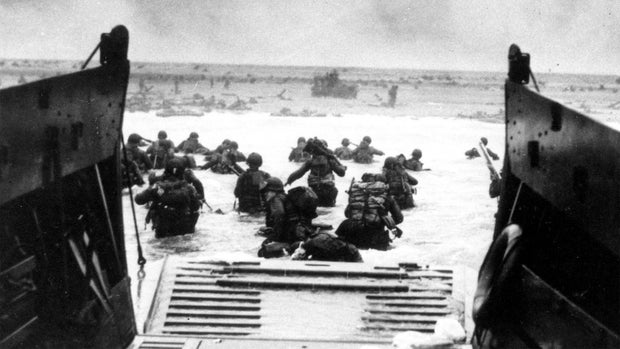On the eve of the D-Day invasion, General Dwight Eisenhower spent a few daylight hours with paratroopers about to jump behind German lines into occupied France. A single moment captured by an Army photographer became the most enduring image of America’s largest military operation.
“It’s one of those pictures that just gives you pause,” said James Ginther, an archivist at the Eisenhower Library in Abilene, Kansas. “Something was clearly going on. There was a conversation. but we didn’t know what it was, and it invited us in.”
What makes this image so iconic (the famous photo shoot has even been turned into a selfie station in the library) is that it perfectly captures everything that was on D-Day – the burden of command, and life in the balance.
US Army/Library of Congress
And the more you know about the image, the more perfect it becomes.
Asked why it was so important for Eisenhower to visit the troops the day before the Allied forces landed in Normandy, Ginther replied, “Because wars are not won by armies. They are won by individual soldiers, and he knows the value of that.”
Wallace Strobel — the helmeted soldier in the photo — died in 1999, but he recalled a brief meeting with Eisenhower during an interview with CBS News in 1994. “I was very young; it was my 22nd birthday,” he said. “We were really ready to go. We were all set up, everything was loaded. And someone ran down the street and said, ‘Eisenhower’s here!’ Well, everybody said, ‘So what?’ We have more important things to do!”
No one caught their attention or fell into formation. But then, Strobel remembers, “You could hear the excitement when he came close. So then we turned and kind of looked out, and then he came over and at the point he stopped in front of me.”
Asked why Eisenhower, who commanded two million Allied troops in Operation Overlord, chose to speak to the paratroopers, Ginther said, “Because they were the key to the whole operation.”
The Germans had flooded the area behind the coast, and the paratroopers were jumping in front of the main landing force to seize the causeways leading inland.
CBS News
Strobel’s mission was to defeat the German weapons that could turn the streets into shooting galleries. He said, “He emphasized the fact, ‘Now, if you don’t take that gun at H hour, the whole invasion will fail.'”
Didn’t Strobel know a letter stamped “BIGOT” had landed on Eisenhower’s desk. BIGOT stands for British Invasion of German Occupied Territory. “It’s higher than classified,” Ginther said.
Air Marshal Trafford Leigh-Mallory, the officer in charge of the airdrop, had written, “I am not very happy about US Airborne Operations as currently planned,” and warned that half of the 13,000 paratroopers could be lost.
In a 1964 interview with CBS’s Walter Cronkite, Eisenhower recalled what Leigh-Mallory told him: “He was convinced we were making a terrible mistake, until about a day or two before the attack, he came to see me at my camp. , in below, and he is very firm in his recommendation that it should not be done.”
From the archives: CBS Reports (1964): “D-Day Plus 20 Years – Eisenhower Returns to Normandy” (Video)
It was a call only Eisenhower could make. The response to Leigh-Mallory, hand-delivered the next day, read: “Strong air attacks … are essential to the whole operation and must be continued.”
It was, in Eisenhower’s words, a “soul-wracking decision” – but he didn’t give a clue about when he mingled with the paratroopers an hour before they boarded the plane.
So, what the general said to Lt. Strobel? “He said, ‘Where are you from, lieutenant?’ And I said, ‘Michigan.’ He said, ‘Oh, Michigan, I used to fish in Michigan.’
Martin asked, “So, in the famous photo, he was talking about fish?“
“That’s what Wally Strobel said,” Ginther said.
“It kind of changes preconceptions about the photo. You look at it and you think he’s going, ‘Give ’em hell.’ Maybe he’s going to be like casting?”
Strobel told CBS, “It’s like he’s trying to calm everyone down.”
Eisenhower later told Cronkite paratroopers had tried to put they also: “They were all getting ready and they were all disguised and their faces were black and all this, and they saw me and they knew me and they said, ‘Don’t worry, general, I’ll take care of this for you.’ and things like that it’s a good feeling.
It felt better in the morning, when the main landing force went to the beaches of Normandy. “All preliminary reports are satisfactory,” Eisenhower cabled in his first dispatch. “The air formation seems to be landing well.”
It was too early to predict success, so Eisenhower closed by saying that he had visited the paratroopers the night before, “and the light of war was in his eyes.”
See the rest:
GALLERY: D-DAY – When the Allies turned the tide
For more information:
Story produced by Mary Walsh. Editor: Joseph Frandino.








